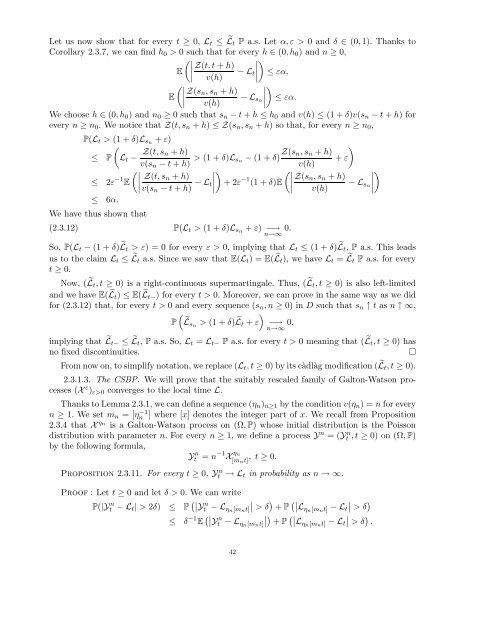arbres aléatoires, conditionnement et cartes planaires - DMA - Ens
arbres aléatoires, conditionnement et cartes planaires - DMA - Ens
arbres aléatoires, conditionnement et cartes planaires - DMA - Ens
Create successful ePaper yourself
Turn your PDF publications into a flip-book with our unique Google optimized e-Paper software.
L<strong>et</strong> us now show that for every t ≥ 0, L t ≤ ˜L t P a.s. L<strong>et</strong> α,ε > 0 and δ ∈ (0,1). Thanks to<br />
Corollary 2.3.7, we can find h 0 > 0 such that for every h ∈ (0,h 0 ) and n ≥ 0,<br />
(∣ ∣) ∣∣∣ Z(t,t + h) ∣∣∣<br />
E<br />
− L t ≤ εα,<br />
v(h)<br />
(∣ ∣) ∣∣∣ Z(s n ,s n + h) ∣∣∣<br />
E<br />
− L sn ≤ εα.<br />
v(h)<br />
We choose h ∈ (0,h 0 ) and n 0 ≥ 0 such that s n − t + h ≤ h 0 and v(h) ≤ (1 + δ)v(s n − t + h) for<br />
every n ≥ n 0 . We notice that Z(t,s n + h) ≤ Z(s n ,s n + h) so that, for every n ≥ n 0 ,<br />
P(L t > (1 + δ)L sn + ε)<br />
(<br />
≤ P L t − Z(t,s n + h)<br />
v(s n − t + h) > (1 + δ)L s n<br />
− (1 + δ) Z(s )<br />
n,s n + h)<br />
+ ε<br />
v(h)<br />
(∣ )<br />
(∣ ∣)<br />
∣∣∣<br />
≤ 2ε −1 Z(t,s n + h)<br />
E<br />
v(s n − t + h) − L ∣∣∣ t∣<br />
+ 2ε −1 Z(s n ,s n + h) ∣∣∣<br />
(1 + δ)E<br />
− L sn<br />
v(h)<br />
≤ 6α.<br />
We have thus shown that<br />
(2.3.12) P(L t > (1 + δ)L sn + ε) −→<br />
n→∞<br />
0.<br />
So, P(L t − (1 + δ) ˜L t > ε) = 0 for every ε > 0, implying that L t ≤ (1 + δ) ˜L t , P a.s. This leads<br />
us to the claim L t ≤ ˜L t a.s. Since we saw that E(L t ) = E( ˜L t ), we have L t = ˜L t P a.s. for every<br />
t ≥ 0.<br />
Now, ( ˜L t ,t ≥ 0) is a right-continuous supermartingale. Thus, ( ˜L t ,t ≥ 0) is also left-limited<br />
and we have E( ˜L t ) ≤ E( ˜L t− ) for every t > 0. Moreover, we can prove in the same way as we did<br />
for (2.3.12) that, for every t > 0 and every sequence (s n ,n ≥ 0) in D such that s n ↑ t as n ↑ ∞,<br />
(<br />
P ˜Lsn > (1 + δ) ˜L<br />
)<br />
t + ε<br />
−→ 0,<br />
n→∞<br />
implying that ˜L t− ≤ ˜L t , P a.s. So, L t = L t− P a.s. for every t > 0 meaning that ( ˜L t ,t ≥ 0) has<br />
no fixed discontinuities.<br />
□<br />
From now on, to simplify notation, we replace (L t ,t ≥ 0) by its càdlàg modification ( ˜L t ,t ≥ 0).<br />
2.3.1.3. The CSBP. We will prove that the suitably rescaled family of Galton-Watson processes<br />
(X ε ) ε>0 converges to the local time L.<br />
Thanks to Lemma 2.3.1, we can define a sequence (η n ) n≥1 by the condition v(η n ) = n for every<br />
n ≥ 1. We s<strong>et</strong> m n = [ηn −1 ] where [x] denotes the integer part of x. We recall from Proposition<br />
2.3.4 that X ηn is a Galton-Watson process on (Ω, P) whose initial distribution is the Poisson<br />
distribution with param<strong>et</strong>er n. For every n ≥ 1, we define a process Y n = (Yt n ,t ≥ 0) on (Ω, P)<br />
by the following formula,<br />
Yt n = n −1 X ηn<br />
[m , t ≥ 0.<br />
nt]<br />
Proposition 2.3.11. For every t ≥ 0, Y n t → L t in probability as n → ∞.<br />
Proof : L<strong>et</strong> t ≥ 0 and l<strong>et</strong> δ > 0. We can write<br />
P(|Yt n − L t| > 2δ) ≤ P (∣ ) (∣ ∣ )<br />
∣ Y<br />
n<br />
t − L ηn[m<br />
∣ nt] > δ + P ∣Lηn[m nt] − L t > δ<br />
≤ δ −1 E (∣ ∣ Y<br />
n<br />
t − L ηn[m<br />
∣ ) nt] + P (∣ ∣ )<br />
∣ Lηn[mnt] − L t > δ .<br />
42

















